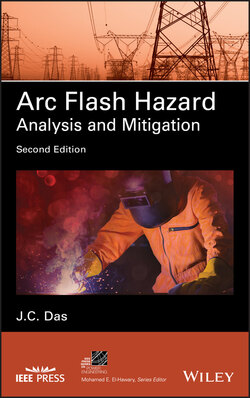Читать книгу Arc Flash Hazard Analysis and Mitigation - J. C. Das - Страница 12
PREFACE TO FIRST EDITION
ОглавлениеThe arc flash hazard analysis has taken the industry by storm, as evidenced by a spate of technical papers in the current literature, especially in IEEE Industry Application Society Petroleum and Chemical Industry, Industrial and Commercial Power Systems, Pulp and Paper Industry Technical Conferences, and the IAS Safety Workshop. The concerns of worker safety in electrical environment are making new strides with respect to equipment innovations, electrical system designs, and arc flash analysis and its mitigation. This impetus has attracted the attention of the industry to bring forward new product innovations, and it has challenged the expertise of practicing and consulting engineers to innovate electrical power system designs and relay protections. The current technical papers and literature address one or the other aspect of this subject. There is no comprehensive published work on this important subject.
This book fulfills this gap. All the aspects of arc flash hazard calculations, which include short circuits, protective relaying, differential relays, arc flash detection relays, relay coordination, grounding systems, arc resistant equipment, current transformer performance, and the like, are included in easy-to-understand language with a number of case studies, practical applications, and references. Current technologies and arc flash mitigation strategies, such as coordination on instantaneous basis, current limiting devices, zone interlocking, and equipment innovations, are covered. Appendix B provides tabulated statements for quick look up of arc flash hazards in electrical power systems. Chapter 13 is devoted to secondary protection of substation transformers because of its importance in arc flash hazard reduction. The critique of IEEE 1584 Guide methodology by various authors and improvements in safety culture and work ethics are discussed. A new algorithm for the calculation of arc flash hazard accounting for the decaying nature of the short-circuit currents, first presented in IEEE Industry Application Transaction papers by the author, is included.
The IEEE 1584 Guide does not cover arc flash hazard calculations in DC systems. Chapter 15 provides detailed short-circuit calculations in DC systems and then their applications to arc flash hazard calculations in DC systems. Chapter 16 discusses application of Ethernet and IEC 61850 communication protocols in a large industrial system for control, diagnostics, and data accessibility.
The book is written for practicing engineers, consultants, electrical power systems managers, and operating personnel. Some sections require undergraduate-level or higher knowledge of electrical power systems. The book should attract a wide readership due to the ever-increasing importance of this subject in recent times.
J.C. Das
